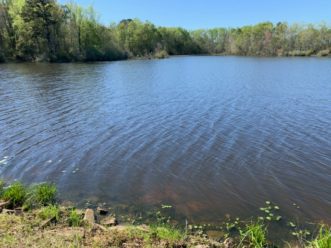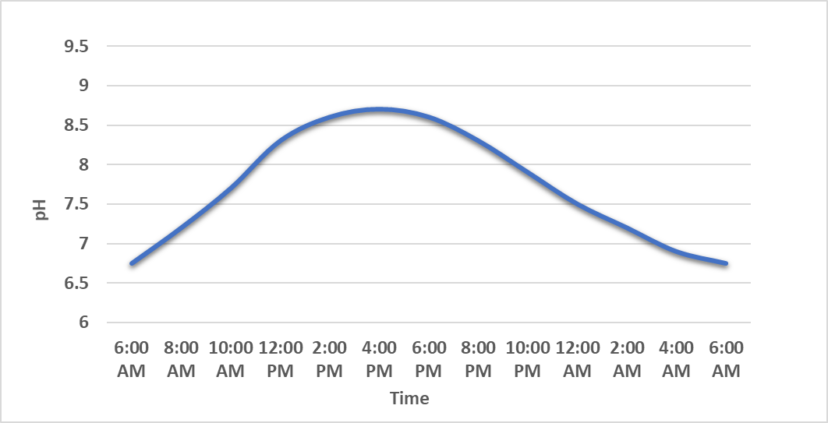Recreational ponds are a unique addition to any landscape and offer many benefits to the owner. Recreational ponds typically provide one or more of these common goals: visual amenity, fishing, swimming, wildlife, or bird watching, or waterfowl hunting. While a pond can frequently support more than one goal, the pond design and maintenance may differ depending on use. Many questions need to be answered before a management plan can be developed for the pond. This article discusses pond design, the natural life span of a pond, water quality, potential concerns, and possible funding to defray the cost of pond management.
Pond Design
Pond design features can be difficult to modify once built and play a critical role in a pond’s functionality. The location of a pond will determine the water source and the watershed size. Pond design information provided by the US Department of Agriculture Natural Resource Conservation Service (USDA NRCS) for agricultural ponds may also be useful when planning a recreational pond.
Common water sources include streams, groundwater seeps or springs, surface runoff, or any combination thereof. Generally, spring-fed ponds have a fairly low risk of water quality problems, while ponds with a significant inflow of surface runoff will often have higher levels of bacteria, phosphorus, and algae.1
The watershed size should be sufficient to provide suitable water flow. Typically, in South Carolina, the target watershed to pond ratio should be approximately ten to twelve acres of watershed to one acre of pond.2 The inflow volume should provide enough water to keep the pond full much of the time and prevent the water from becoming stagnant while not causing excessive flushing from the pond. The pond’s residence time, the amount of time water spends in a pond, depends on the volume of flow into and out of the pond. Ponds less than five acres in size commonly have a 100- to 200-day residence time. A fast residence time (less than ninety days) may flush amendments (e.g., pond dye, herbicides) out of the pond too quickly.1
A pond’s physical characteristics play a significant role in how the pond functions and what goals are reasonably achievable (figure 1). For example, creating a robust largemouth bass fishing experience will be difficult in a pond less than one-half acre in size.3 Variability (in depth, shoreline shape, pond bottom shape, pond bottom material, and vegetation) can provide a range of habitat opportunities that benefit fish and other wildlife. Additional guidelines include:
- Pond depth should typically range from three to ten feet for general recreational use or four to eight feet for fishing ponds. Deeper ponds will likely develop thermal stratification, which can cause fish kills and impact other aquatic species (figure 2). Shallow ponds may support excessive rooted aquatic weed growth, which is generally undesirable unless the objective is to encourage waterfowl.
- Structural habitat, such as logs or vegetation, should cover 10% to 25% of the pond bottom to provide locations for fish to hide, hunt, feed, reproduce, and rest.4 Strategically placing habitat structures near fishing locations can increase the chances of successful fishing.
- Including trees, shrubs, and herbaceous plants along the shoreline can stabilize the banks, improve water quality, increase visual interest, provide shade, and create habitat for fish or other wildlife. Trees and shrubs should not be allowed to grow on a dam.
- Aquatic plants typically cover 15% to 20% of the water’s surface in a healthy pond.5 Plants provide oxygen to the water, habitat, and shelter for some fish, and their roots can stabilize bottom sediments and pond banks. However, excessive plant growth often occurs and can interfere with access or use of a pond and deplete oxygen levels when large amounts of plants die back.
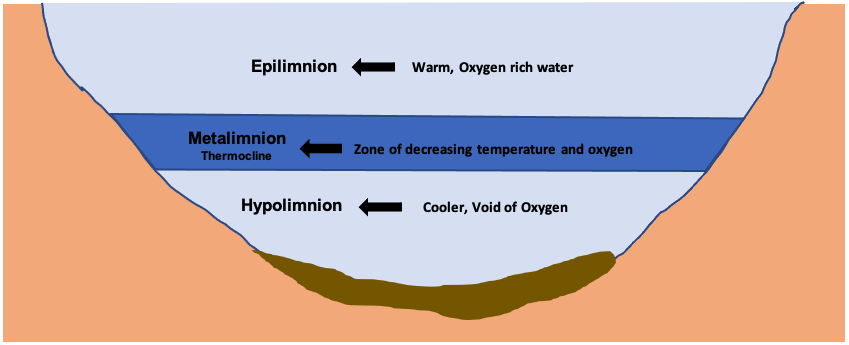
Figure 2. Pond stratification can occur during the summer months when water in a pond can separate into distinct layers. The upper epilimnion layer is warmer and has oxygen-rich water where primary productivity often occurs. The lower hypolimnion layer is cooler and without adequate oxygen to sustain life. The metalimnion, or thermocline, separates and limits interaction between the two layers. Image credit: Lance Beecher, Clemson University.
Recreational Pond Life Cycle
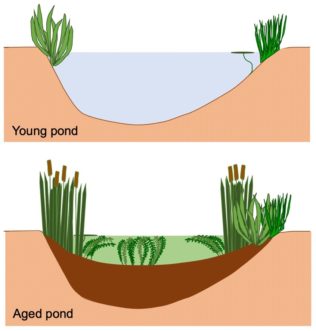
Figure 3. Over time, ponds typically accumulate sediment and develop abundant plant growth. Image credit: Sarah White, Clemson University.
As with all infrastructure, ponds have an expected lifespan and begin aging almost immediately after construction. A young pond typically has little sediment build-up, low nutrient levels, and minimal aquatic plant growth (figure 3). Streams and surface runoff transport sediment and nutrients into ponds from surrounding lands. Over time, nearly all ponds will gradually fill in as organic materials and sediment accumulate on the bottom. Older ponds often have significant sediment accumulation, reduced water storage capacity, high nutrient levels, and abundant aquatic plant or algae growth.6
The aging process usually occurs slowly over many years, and ponds should last at least twenty years.7 However, aging can be significantly accelerated by actions throughout the drainage area. Many land management and development activities result in exposed soil, which rainwater can easily erode and carry into a nearby waterway. Additional factors that contribute to the speed of aging include a large drainage area,8 heavy fertilizer use, addition of substantial organic material, and significant upstream land clearing or development.
Preventative actions to slow a pond’s aging process include establishing vegetation on areas with exposed soils, reducing the volume and velocity of surface runoff, stabilizing streambanks, and establishing riparian buffers with diverse native plants bordering waterways and ponds.9 Actions to restore an older pond may focus on removing sediment, reducing nutrient levels, restoring water storage capacity, and controlling aquatic plant growth. Examples include dredging, aeration, winter drawdowns, the stocking of biological control agents, or chemical control (herbicides) of plants.
Water Quality
Water quality is essential to the recreational use of ponds. Depending on the primary goal for the pond, important water quality parameters to monitor could include bacteria, water temperature, dissolved oxygen, pH, alkalinity, and nutrient load (table 1). Monitoring these parameters regularly and maintaining good records will assist in pond management decisions. Additionally, some water quality parameters impact the toxicity of herbicides, so it’s crucial to know existing concentrations before use. Pond owners can submit samples to Clemson’s Ag Service Lab. The most useful information will likely be provided by a combination of tests: for water samples, the “Special” analysis, and for pond bottom soil samples, the “Standard Soil Test” and the “Pond Bottom” analyses.
Certain bacteria can cause illness in humans or animals and may be present in waterways. In South Carolina, E. coli is used as an indicator of water safety. Low E. coli levels are essential for safe recreation that involves human contact with the water. Bacteria levels in freshwater can change rapidly. The SC Adopt-A-Stream program has a monitoring site webpage that provides information on volunteer sampling data for some locations.
Table 1. Suggested water quality targets for recreational ponds.
| Parameter | Ideal Range | Stress | *SC Water Quality Standard for Freshwaters10 |
| Bacteria: E. coli (MPN/100ml) | 0 | (Humans, Animals) >126 | <126 MPN/100ml (monthly average)
<349 MPN/100ml (daily maximum) |
| Temperature (°F) | (Bass11) 70 to 80
(Trout12) 55 to 65 |
(Bass) <54 or >95
(Trout12) ≥75 |
≤5°F above **natural conditions
Maximum of 90°F |
| Dissolved Oxygen (mg/L) | 5 to 8 | (Fish) <5 or >8 | ≥ 5.0 mg/l (daily average)
Minimum of 4.0 mg/l |
| pH | (Fish13) 6.5 to 9.0 | (Fish13) <4 or >11 | 6.0 to 8.5 |
| Alkalinity (mg/L) | (Fish14) 25 to 100 | (Fish14) <20 or >300 | |
| Hardness (mg/L = ppm) | (Fish15) 40 |
Note: *SC Water Quality Standards may vary with region, water classification, or waterbody type; the values listed are generally the most widely applicable standard to waters throughout South Carolina unless otherwise specified.
**SC Water Quality Standards define “natural conditions” as “unaffected by anthropogenic sources of pollution.”
Water temperature and dissolved oxygen are critical for biological growth and influence water chemistry. Fish have preferred temperature ranges and need plenty of dissolved oxygen to survive.
Sudden changes in water conditions can disrupt the health of the fish and may make them more susceptible to disease. During the warmer summer season, ponds can become stratified with warmer water on the surface and cooler water below (figure 2). A quick mixing of these water layers, often due to severe weather or significant rain events, can result in rapid temperature changes and decreases in dissolved oxygen that may cause a fish kill.16 Additional factors that may cause low dissolved oxygen levels include sudden algal or aquatic plant die-offs and the decomposition of excess organic matter.
The pH and alkalinity are important parameters that offer stability to the health of the pond and the included biota. The pH is the measure of how acidic or basic a solution is, with a pH of 7 being neutral. Water pH fluctuates throughout the day (figure 4), especially in water with low alkalinity (table 1). Alkalinity, including carbonates, bicarbonates, and other compounds, helps stabilize water pH and influences the availability of nutrients. Lime addition is primarily responsible for increasing alkalinity and increases the solubility of phosphorus.17
Fundamental nutrients, such as nitrogen and phosphorus, are essential but can lead to harmful problems at excessive levels. Nutrients are the basis for primary production, which is the beginning of a complete food web to support an abundance of healthy fish populations. Over time, nutrient levels in ponds generally increase due to surface runoff, increased organic matter, and accumulation of sediment in ponds. Phosphorus is usually the limiting factor in freshwaters. High phosphorus levels can drive excessive plant and algae growth that may physically interfere with fishing and degrade the pond’s aesthetic value.
Potential Concerns
Excess Sedimentation
Sediment accumulation in the pond reduces the water storage capacity, decreases water depth, and can become a source of nutrients. Sources of sediment include erosion from bare ground, wildlife, livestock, and human activities. Collectively, these changes may interfere with use of the pond and may increase maintenance needs. Frequently, aquatic plant growth becomes excessive and may require significant effort to control.
Preventive efforts to reduce erosion and slow sedimentation of ponds can provide long-term benefits. If sediment accumulation is interfering with the use of a pond, dredging may be necessary to restore the intended water depth and volume storage capacity.
Excess Plant or Algae Growth
Excessive plant growth is a common challenge for pond owners and is typically driven by high nutrient levels or shallow water depth that allows sunlight to reach the bottom of the pond. Taking steps to prevent nutrient inputs to the pond is critical to reducing plant growth. Specific sources of nutrients may vary by pond. Examples of common sources include fertilizer; soil erosion; feed provided to fish; and human, pet, or livestock waste.
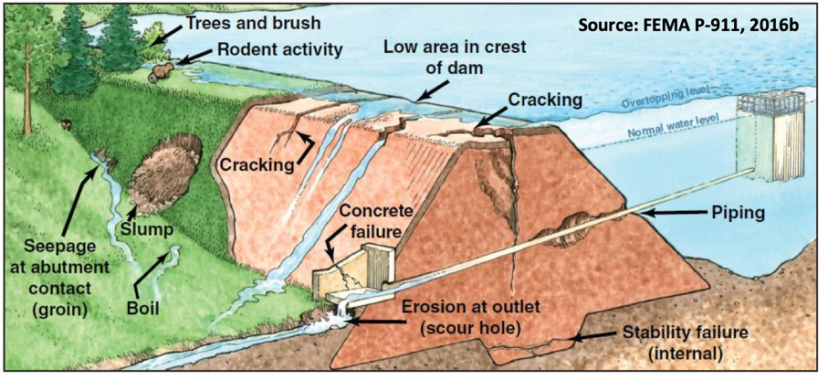
Figure 5. Common failure modes of a dam. Image credit: US Department of Homeland Security, Federal Emergency Management Agency.18
Dam Maintenance and Repair
While many small dams are unregulated, proper maintenance of all dams is critical to avoid failure and potential downstream impacts that could involve legal liability for the dam owner. Visual inspections should be conducted at least once a year and after significant rain events to identify changes or unusual conditions. Signs of dam failure should be addressed quickly and may require the services of a qualified engineer.
Grassy vegetation can help prevent erosion, but woody vegetation should not be allowed on a dam. Tree and shrub roots can threaten the dam’s structural integrity, and the habitat may be inviting to burrowing animals.19
Aquatic Mammals
Your pond may become a home for beavers (Castor canadensis), muskrats (Ondatra zibethica), or river otters (Lutra canadensis). River otters are not typically a concern for pond owners. However, beavers and muskrats may burrow into your dam or pond banks. Additionally, beavers will work to block the flow of water and may clog your outfall with sticks. Techniques, such as the Clemson Beaver Pond Leveler, featured in a past Clemson Cooperative Extension leaflet, may help prevent beavers from successfully blocking water flow.20 Trapping, transport, or dispatch of these animals is regulated under SC state law, and a license is required.21
Feral Hogs
Feral hogs (aka wild boars, Sus scrofa) cause approximately $1.5 billion in agricultural damage each year across the United States.22 Additionally, they can carry a variety of diseases that affect humans, livestock, and other wildlife.22 The population is estimated at $6 million in South Carolina and is increasing rapidly. Hogs are opportunistic and are attracted to ponds to cool themselves and forage on the nearby plants and eggs of nesting birds. Their rooting and wallowing cause erosion, introducing nutrients and bacteria to the pond. They also disrupt the ecosystem by spreading invasive plants and killing invertebrates.23 While a hunting permit may be required (if on public land), South Carolina’s regulations generally encourage activities to manage feral hog populations. 24
Canada Geese
Although classified as migratory birds (and protected under applicable federal laws), the number of year-round resident Canada geese (Branta canadensis) is increasing.25 Ponds with open or turf shorelines provide a clear line of sight, offer safety from predators, and encourage geese to stay for the long term. Considering a single goose can produce up to two pounds of waste per day, resident geese can quickly lead to high nutrient and bacteria levels in your pond.26 One cost-effective solution is planting dense vegetation that is at least twenty-four inches tall along the shoreline.27
Funding Improvements
The owner of a private recreational pond is typically responsible for funding dam maintenance and other pond management projects. If your recreational pond also serves an agricultural purpose (e.g., irrigation), qualifying projects may be eligible for technical assistance and cost-share funding through the USDA NRCS. Information is available on the USDA NRCS website.28,29 Alternately, if your pond management project will provide water quality improvements (e.g., shoreline buffer enhancement) within select watersheds, funding assistance may be available through the “Section 319” programs managed by the SC Department of Health and Environmental Control. Visit their DHEC Funded Watershed-Based Plans website for more information.30
References Cited
- Swistock B. Pond management for rural and farm pond owners. University Park (PA): The Pennsylvania State University, PennState Extension;2017. https://extension.psu.edu/pond-management-for-rural-and-farm-pond-owners.
- Stone T. Pond construction and tax credits. Washington (DC): USDA Natural Resources Conservation Service; [accessed 2021 Mar 18]. https://www.clemson.edu/extension/carolinaclear/files/files%202/tstone_pondconstruct2.pdf.
- Beem M. Improve fishing in your pond. Stillwater (OK): Oklahoma State Extension; 2018 May. Id: NREM-9209. https://extension.okstate.edu/fact-sheets/improve-fishing-in-your-pond.html.
- Neal JW, Willis DW. Small impoundment management in North America. Bethesda (MD): American Fisheries Society; 2012.
- Lynch Jr. WE. Benefits and disadvantages of aquatic plants in ponds. Columbus (OH): Ohio State University Extension, School of Environment and Natural Resources; 2006. Extension fact sheet A-17-06.
- Holtz J. Pond and lakes lifecycle. Aix-en-Provence, France: Irrigazette; 2013 May. https://irrigazette.com/en/news/pond-and-lakes-lifecycle#.
- USDA NRCS. Operation and maintenance guide for your pond. Bozeman (MT): USDA Natural Resources Conservation Service Montana; 2009. https://www.nrcs.usda.gov/Internet/FSE_DOCUMENTS/nrcs144p2_050373.pdf.
- Nebraska Game Parks. Nebraska pond guide. Lincoln (NE): ; 2015 Nov. PG13-1. https://outdoornebraska.gov/wp-content/uploads/2015/11/PMGS_Construction.pdf.
- USDA Conservation Stewardship Program. Conservation enhancement activity: Fishpond management for native aquatic and terrestrial species. Washington (DC): USDA Natural Resources Conservation Service; 2017. https://www.nrcs.usda.gov/wps/PA_NRCSConsumption/download?cid=nrcseprd1379922&ext=pdf.
- Regulation 61-68 Water Classifications and Standards. SC Code Sections 48-1-10. Columbia (SC): S.C. Department of Health and Environmental Control; 2019 https://live-sc-dhec.pantheonsite.io/sites/default/files/media/document/R.61-68.pdf.
- Delince G. The ecology of the fish pond ecosystem. Amsterdam, The Netherlands: Kluwer Academic Publishers; 1992. p. 230. http://hdl.handle.net/1854/LU-222385.
- NRCS Field Office Technical Guide. Pond management for trout. Washington (DC): USDA Natural Resources Conservation Service; [accessed 2021 Apr 02] 2002. https://efotg.sc.egov.usda.gov/references/public/AZ/Trout,_pond_management.doc
- Ekubo AA, Abowei JFN. Review of some water quality management principles in culture fisheries. Research Journal of Applied Sciences, Engineering and Technology. 2011;3(2):1342-1357.
- Stone NM, Thomforde HK. Understanding your fish pond water analysis report. Pine Bluff (AR): University of Arkansas at Pine Bluff, Cooperative Extension Program; 2004.
- Boyd CE, Tucker CS, Somridhivej B. Alkalinity and hardness: critical but elusive concepts in aquaculture. Journal of the World Aquaculture Society. 2016;47(1):6-41. doi:10.1111/jwas.12241
- Hasan K, Alam K, Chowdhury MSA. The use of an aeration system to prevent thermal stratification of water bodies: pond, lake and water supply reservoir. Applied Ecology and Environmental Sciences. 2014;2(1):1-7. doi:10.12691/aees-2-1-1.
- Boyd CE. Practical aspects of chemistry in pond aquaculture. The Progressive Fish-Culturist. 1997;59(2):85-93. 10.1577/1548-8640(1997)0592.3.CO;2.
- FEMA. Dam awareness: technical advisory 3 – North and South Carolina. Washington (DC): US Department of Homeland Security, Federal Emergency Management Agency; 2017. DR-4285-NC and DR-4286-SC. https://www.fema.gov/sites/default/files/2020-08/ta3-dam_awareness.pdf.
- FEMA. Technical manual for dam owners: impacts of plants on earthen dams. Washington (DC): US Department of Homeland Security, Federal Emergency Management Agency; 2005. FEMA 534. https://www.fema.gov/sites/default/files/2020-08/fema-534.pdf
- Minnesota DNR. The Clemson beaver pond leveler. St. Paul (MN): State of Minnesota, Department of Natural Resources; 2001. http://files.dnr.state.mn.us/assistance/backyard/privatelandhabitat/clemson_beaver_pond_leveler.pdf
- Water Resources Program Team. Beavers, muskrats and otters. Clemson (SC): Clemson University Cooperative Extension; [accessed 2021 Mar 04] 2021. https://www.clemson.edu/extension/water/stormwater-ponds/problem-solving/nuisance-wildlife/beavers-muskrats/index.html.
- SC DNR. Feral hog – damage and diseases. Columbia (SC): SC Department of Natural Resources; [accessed 2021 Apr 2] 2020. https://www.dnr.sc.gov/wildlife/hog/damage.html
- USDA Animal and Plant Health Inspection. Feral swine – managing an invasive species. Washington (DC): USDA. [accessed 2021 Apr 9] https://www.aphis.usda.gov/aphis/resources/pests-diseases/feral-swine.
- Mayer J, Yarrow G, Thom T, Myers N, Lenard D. South Carolina’s growing wild hog problem: recommendations for management and control. Columbia (SC): SC Department of Natural Resources, South Carolina Wild Hog Task Force; [accessed 2021 Apr 2] https://www.dnr.sc.gov/wildlife/hog/pdf/wildhogwhitepaper.pdf.
- Canada Goose Information. Columbia (SC): SC Department of Natural Resources; [accessed 2021 Mar 04] 2020. https://www.dnr.sc.gov/wildlife/waterfowl/cgoose/index.html.
- Orscheln N, Callahan K. Resident Canada geese: along the waterfront. Clemson (SC): Clemson Cooperative Extension, Home & Garden Information Center; 2013 Apr. HGIC 1853. https://hgic.clemson.edu/factsheet/resident-canada-geese-along-the-waterfront/.
- Orscheln N, Callahan K. Resident Canada geese: management options. Clemson (SC): Clemson Cooperative Extension, Home & Garden Information Center; 2013 Apr. HGIC 1854. https://hgic.clemson.edu/factsheet/resident-canada-geese-management-options/.
- Financial Assistance. Columbia (SC). US Department of Agriculture, Natural Resource Conservation Service, South Carolina. [accessed 2021 Mar 04] https://www.nrcs.usda.gov/wps/portal/nrcs/main/sc/programs/financial/.
- Easements. Columbia (SC). US Department of Agriculture, Natural Resource Conservation Service, South Carolina. [accessed 2021 Mar 04]. https://www.nrcs.usda.gov/wps/portal/nrcs/main/sc/programs/easements/.
- DHEC Funded Watershed-Based Plans. Columbia (SC). South Carolina Department of Health and Environmental Control. [accessed 2021 Mar 04] 2019. https://scdhec.gov/environment/your-water-coast/watersheds-program/dhec-funded-watershed-based-plans.
Additional Resources
White SA, Beecher L, Davis RH, Nix HB, Sahoo D, Scaroni AE, Wallover CG. Ponds in South Carolina. Clemson (SC): Clemson Cooperative Extension, Land-Grant Press by Clemson Extension; 2021 Jul. LGP 1114. https://lgpress.clemson.edu/publication/ponds-in-south-carolina.
Whetstone JM, Watson M, Heaton WC. Stocking & harvesting recreational fish ponds. Clemson (SC): Clemson Cooperative Extension, Home & Garden Information Center; 2015. HGIC 1712. https://hgic.clemson.edu/factsheet/stocking-harvesting-recreational-fish-ponds.

